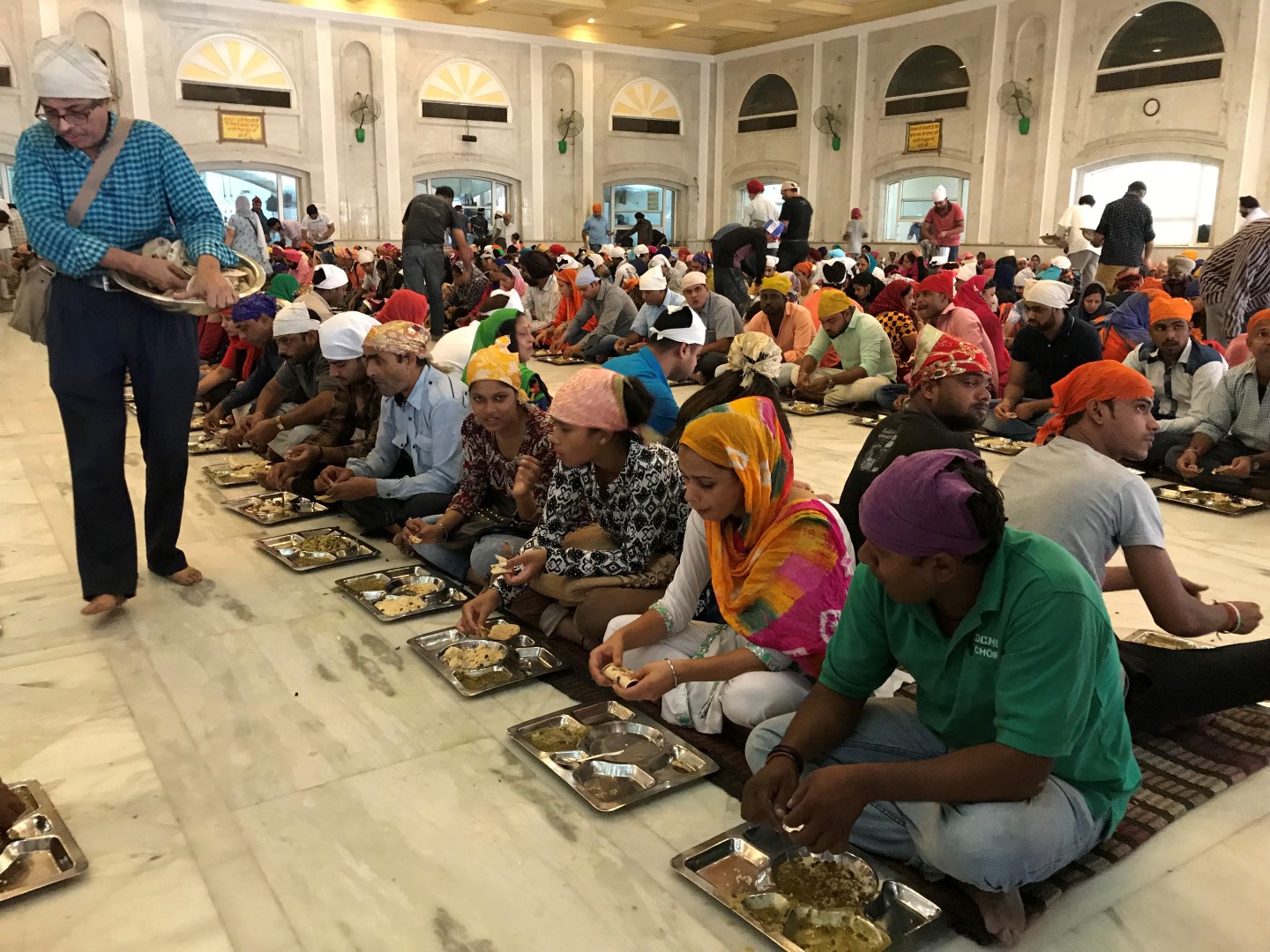We walk past caldrons and woks, each large enough for a person to sit inside. The flames beneath these feed-a-village-sized pots sputter brightly beneath boiling dal, the Indian lentil stew and keer, the Indian rice pudding. Chapatti is cooked on a griddle somewhat the size of a billiard table. Here at the Sikh temple in Old Delhi, India, the temple’s langar, or community kitchen, serves a simple vegetarian meal to all visitors, regardless of religion, caste, gender, ethnicity, or financial need. When you sit for a meal at a Sikh langar, you will be among those in need as well as those who have the most to share.
“We serve 30,000 meals a day. All prepared and served by volunteers in our community,” our guide, one of the many volunteers here at the langar, says.
It’s surprisingly quiet and calm given the level of activity going on, I’m sure I’ve misheard. He continues, “This is not as many meals as the langar in Amritsar serves. The temple in Amritsar, India is the largest Sikh temple in the world. They serve 50,000 meals a day.”
I’m hesitant to get clarification because surely, although his English has been as fluent as my own, he means to say 3,000 and 5,000. But I have to know, and it turns out I’m hearing that figure accurately.
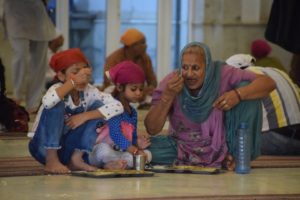
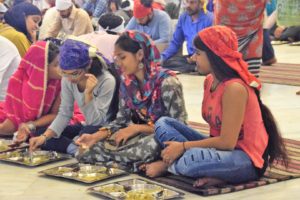
The Tradition of Langars
Langars are a fixture in Sikh temples around the world. Many operate 24 hours a day. And they are not just for the hungry or the homeless. Sikh langars are completely volunteer-run and are an important part of the community. The langar serves to feed those who need a meal, but it’s also a gathering point of the community. Many of those fed come as a way to meet and be with others.
The extraordinary amount of food prepared here is donated by others in the community or purchased from donations to the temple.
Of India’s population of 1.339 billion, 79.80% are Hindu, with Sikhs comprising only 1.7% of the population. The Sikh religion teaches that all humans are equal. Rich or poor, a strong work ethic and volunteering and helping others are strong components of the religion.
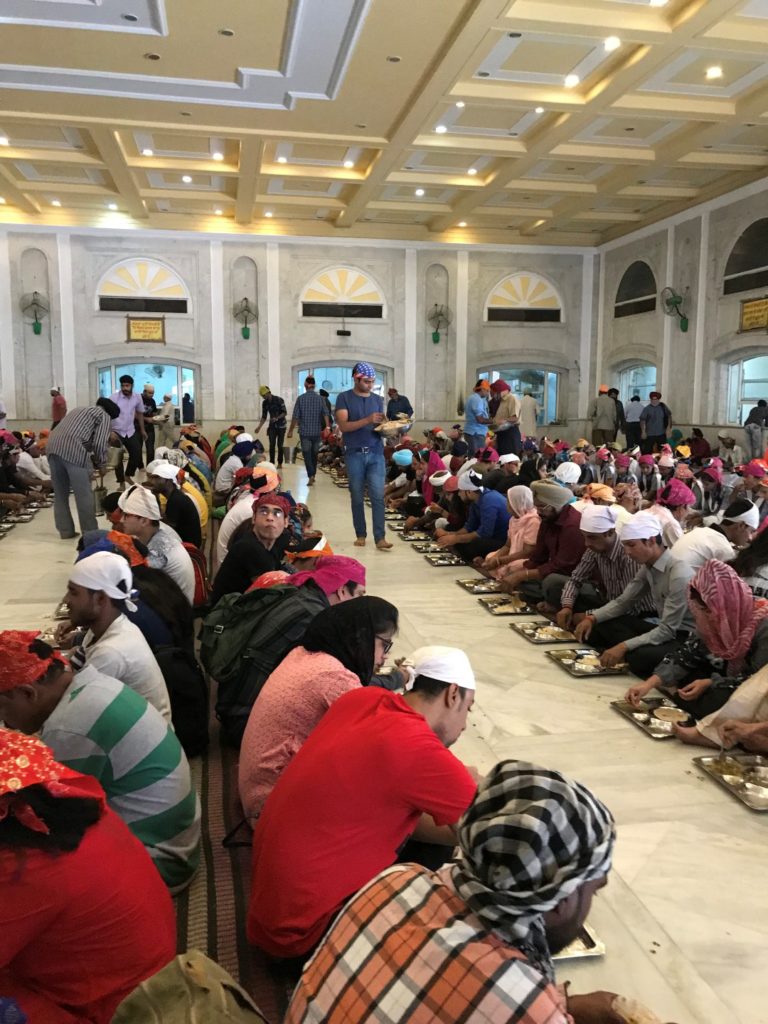
Touring the Kitchens
Before our small group enters the langar for a tour, we cover our heads. The women among us don our scarves. Men and women without head coverings are provided with simple bandanas.
We enter the kitchens. Stations are devoted to each component of the meal. There’s an area where flour and water are mixed for chapatti. Another where rice and dal cook.
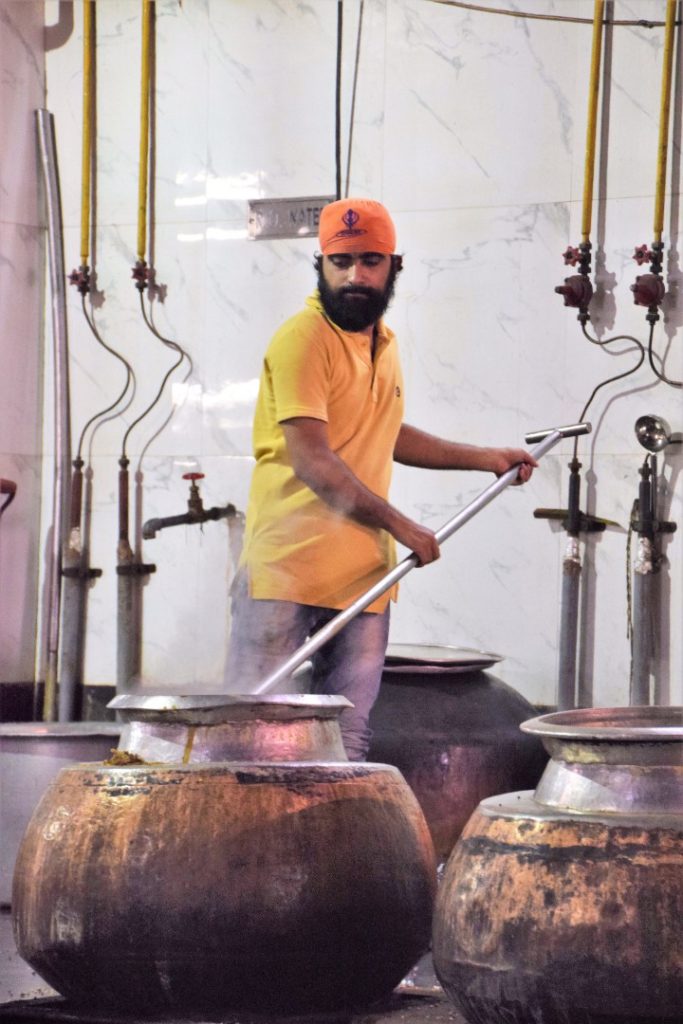
The langar is one of the cleanest places I will visit in India, despite the high traffic of people coming in and out, and the staggering amount of food being prepared.
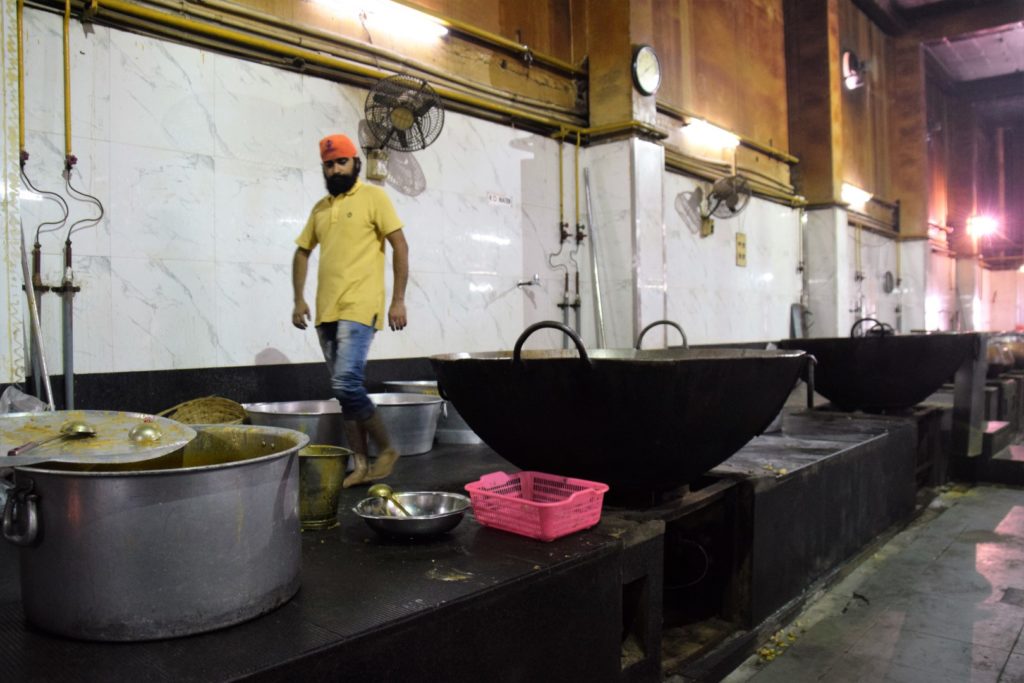
The Cooked Dishes
Each stage of cooking is streamlined. On a high platform, the caldrons and woks bubble with rice and lentils. Men use long wood paddles to stir the cooking food and move the food to smaller containers once cooked.
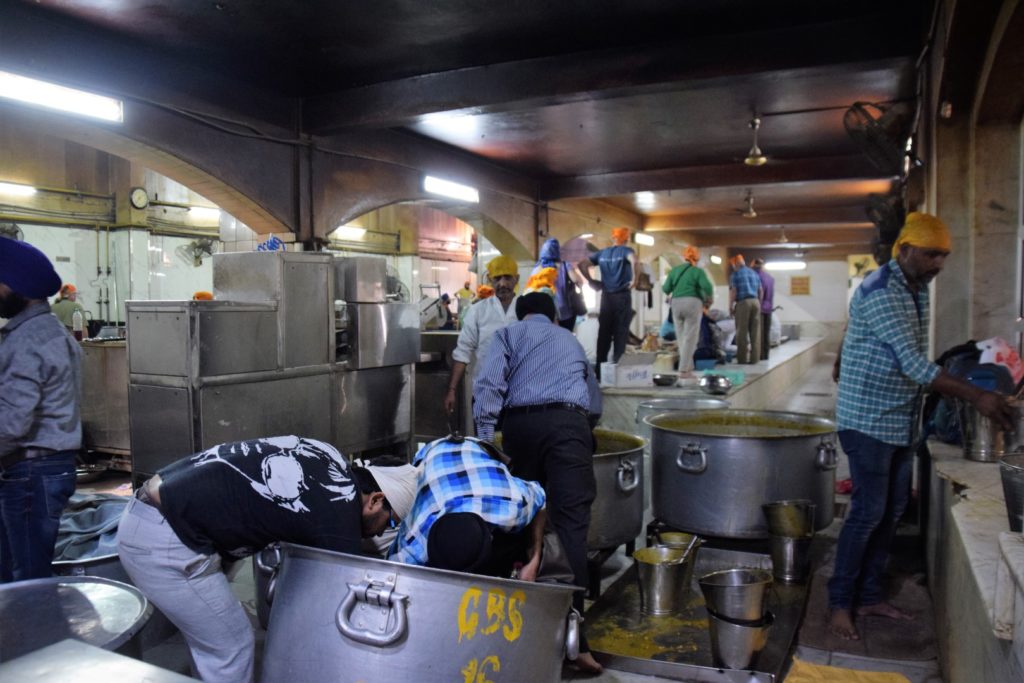
Making Bread
At two long low wood tables, men, women and even a few children sit to roll out rounds of dough for chapatti with small rolling pins. They toss each finished rounds to the center of the table. They’re provided with a new ball of dough each time they complete a round. The rounds are scooped up and taken to where they’ll be cooked.
A few of us in our little group sit to make a couple of rounds. I’m too distracted by all I’m taking in to be efficient. I think the regular volunteers made five or seven in the time it takes for me to make one.
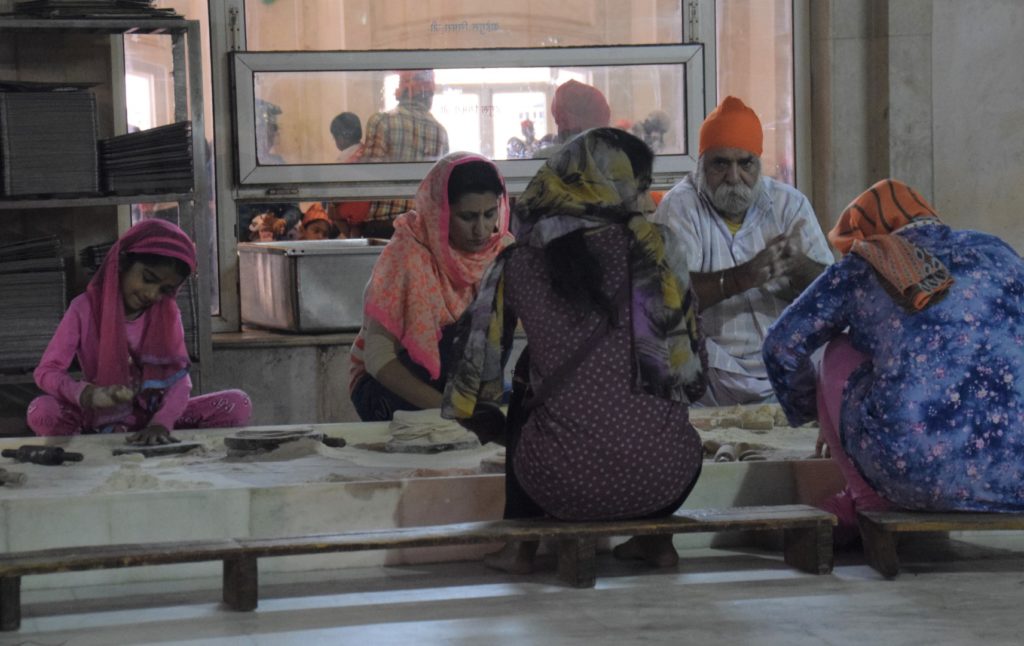
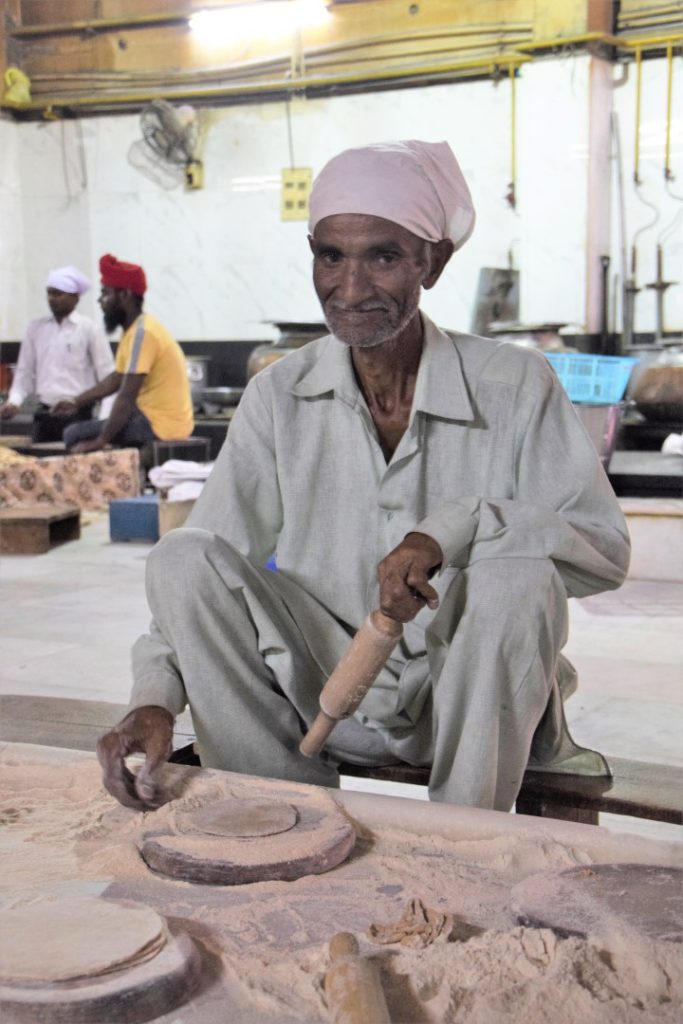
On another side of the room, there’s a griddle that’s about the size of a billiard table where the chapatti is cooked. Men and women sit around the griddle, tossing each round onto it. Two more men use long handled paddles to turn each round. They puff and deflate, and are scooped up off the griddle to cool.
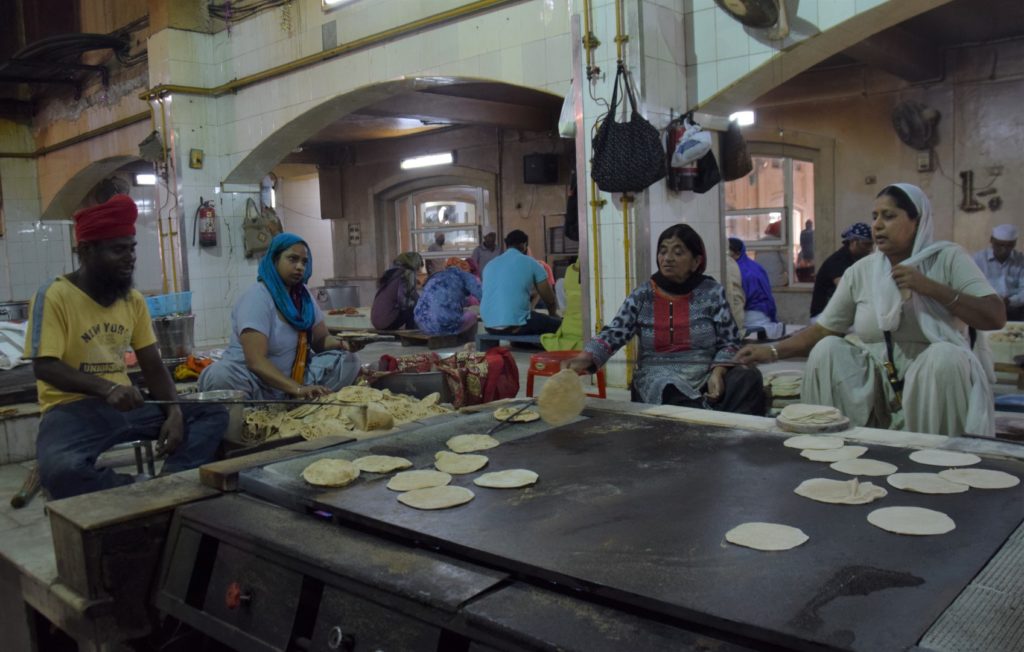
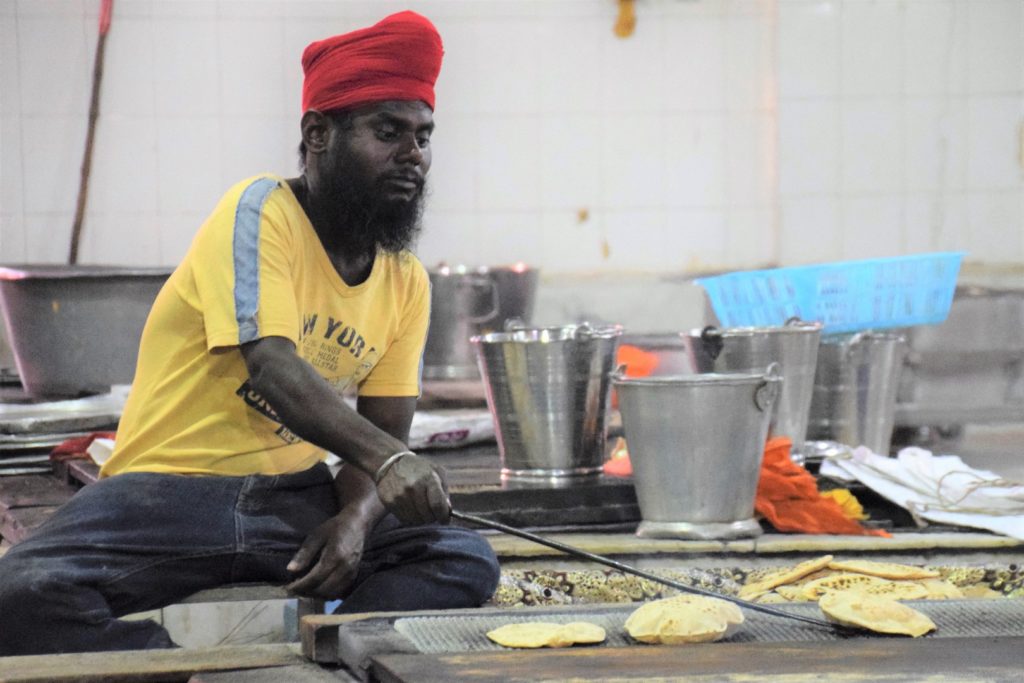
Cleaning Stations
There are cleaning stations both indoors and out. A group of men on duty clean the large pots, as well as plastic cups and the stainless steel thali trays that you see everywhere in India.
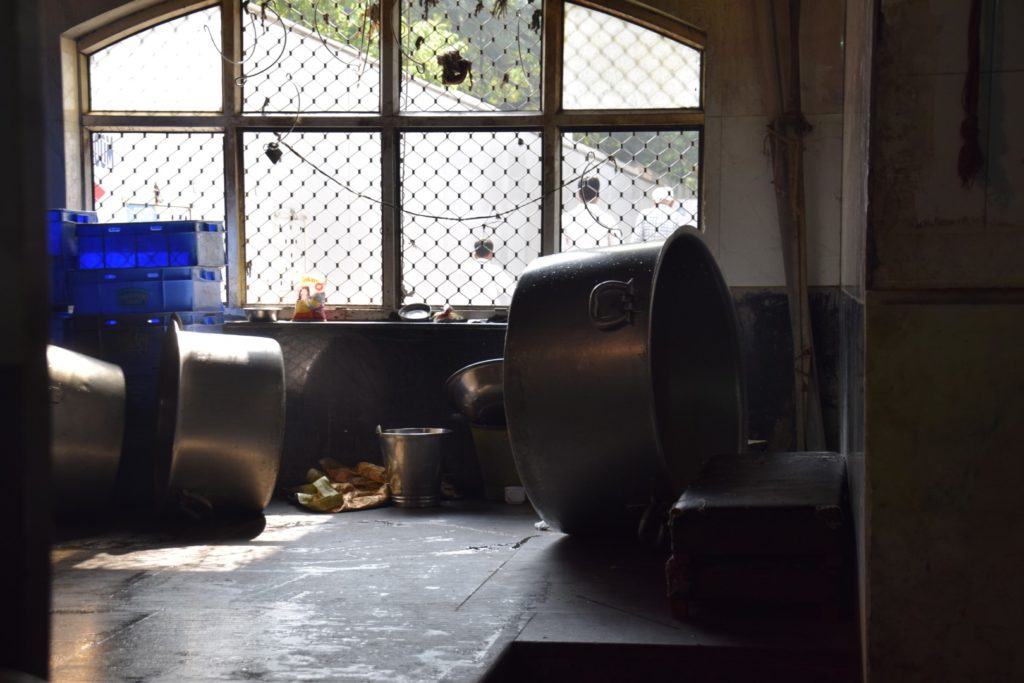
I continue to be amazed at the level of organization created here, and how fast each person moves to complete each task in the process. From beginning to end this is the picture of efficiency. Yet not a single process is rushed. It’s a place of great calm and focus.
Before we exit the indoor kitchen, we stop to where an older gentleman makes a large pot of chai, stirring in tea and spices for the drink I can’t get enough of on our trip. He fills a tray of cups and carries the tray over to us. As I thank him, his smile is wide. No tea ceremony has ever seemed as lovely.
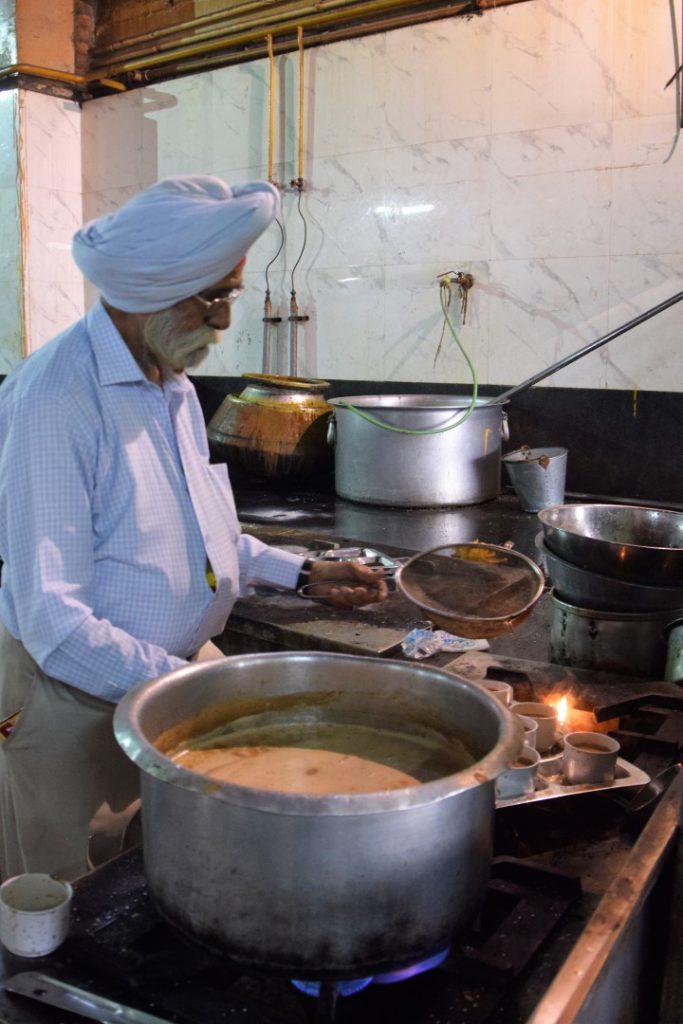
Sit, Enjoy a Meal
Our tour ends. We walk around to the entrance of the dining hall, and wait a short time to enter for lunch. Floor-to-ceiling glass doors swing open and we enter with others waiting in line. The dining hall fills with each sitting, people are fed and then exit when they’re ready out doors at the other end of the room. Another group then fills the hall.
We take a thali plate and settle in. Men and women start walking up and down rows of seated diners. One offers bread. Another ladles dal and another a scoop of keer. Keer is rice cooked with milk and sugar and flavored with cardamom, saffron, nuts, and often, raisins. (Wheat, tapioca, or vermicelli is sometimes used instead of rice.) Our little group stands out; we’re among very few Caucasians here. Everyone else is using bread as their utensil for the rice and lentils. We’re given spoons, for which I admit I’m grateful. I don’t want to leave food on my plate here.
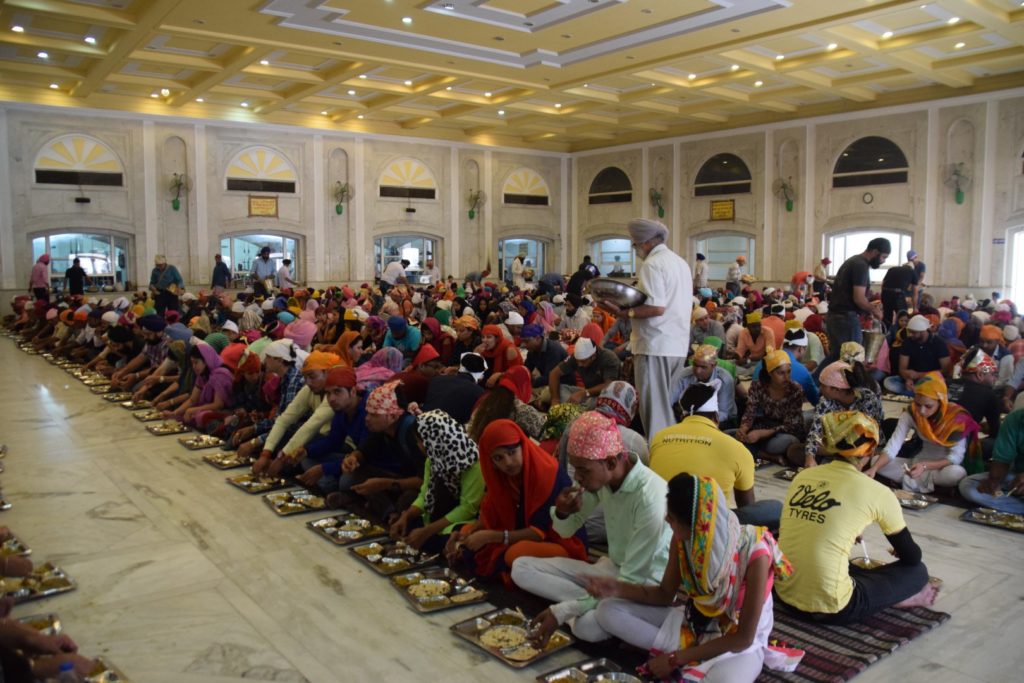
Volunteers continue to come around offering more of each dish. As we leave, we deposit our tray on a stack where just behind us, volunteers are busy washing plates and cups.
Again, everything happens quickly and efficiently, but no one rushes. And so this continues, again and again.
Outdoors, the Giving Continues
Outdoors, we enter a courtyard, heavy with trees and flowers. Stands give away hot and cold food on the run, mostly the fried snacks we see throughout our trip, cooked on the spot. Cups of fruit juice and water are handed out at another area.
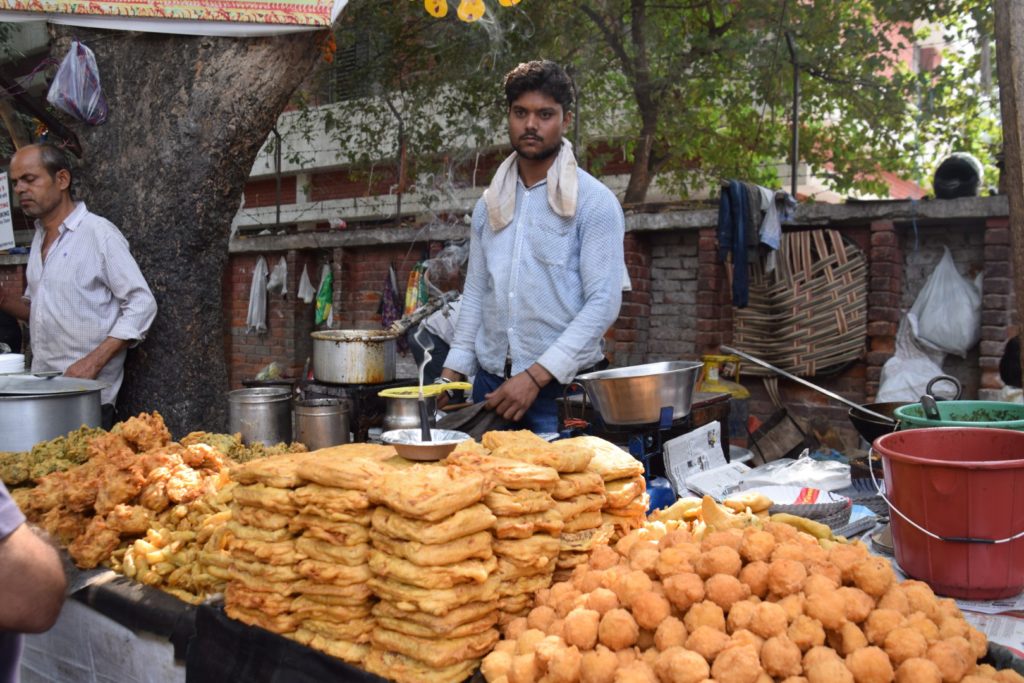
Those who need it are also offered bags of rice and other food stuff to take home. Medicines are dispensed and at times, people in need are sometimes helping with housing.
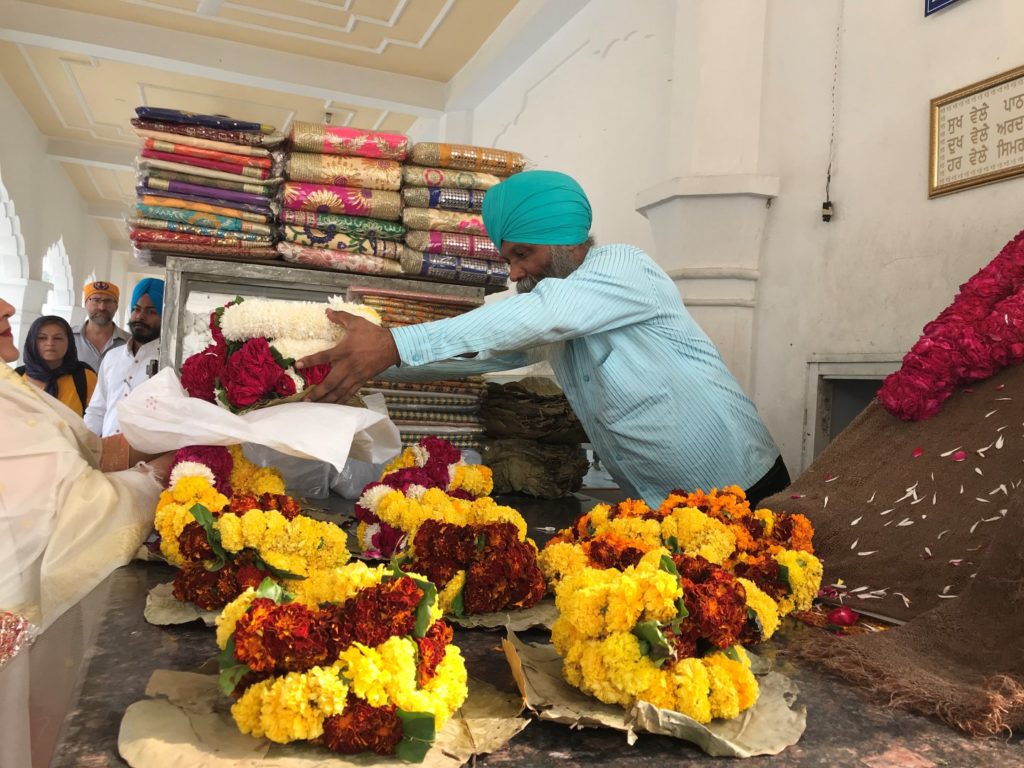
A Temple Visit
We enter the temple, where scripture is chanted continuously. Near the exit, I’m grateful for a small, lone metal donation box, where I make a contribution before we leave.
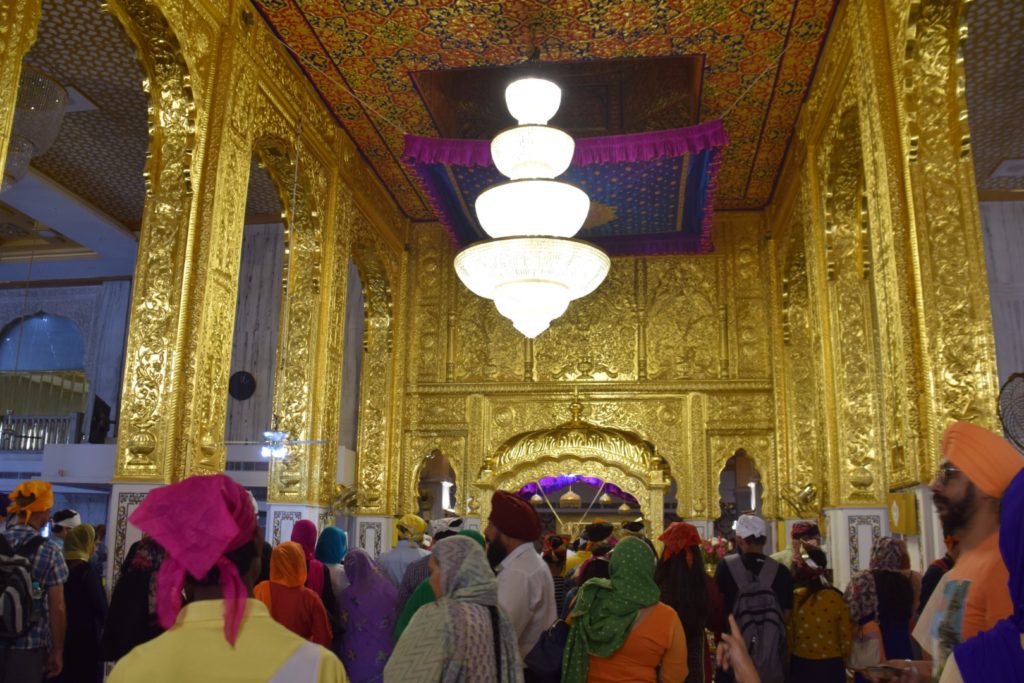
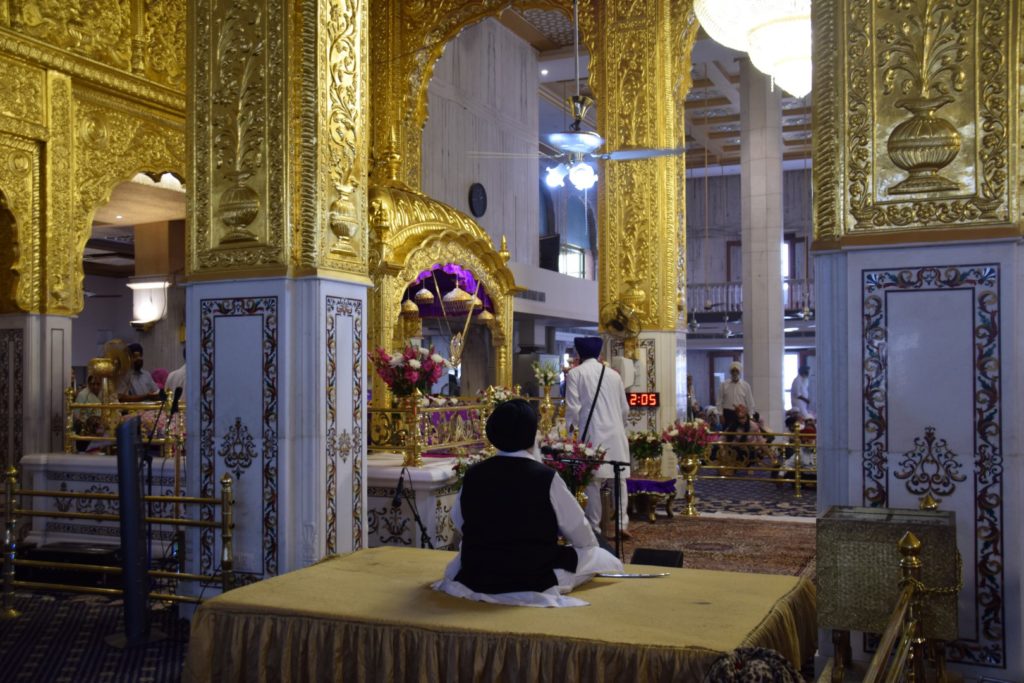
Outdoors again, we walk around the pool, called a sarovar, a feature found at all gurdwaras.
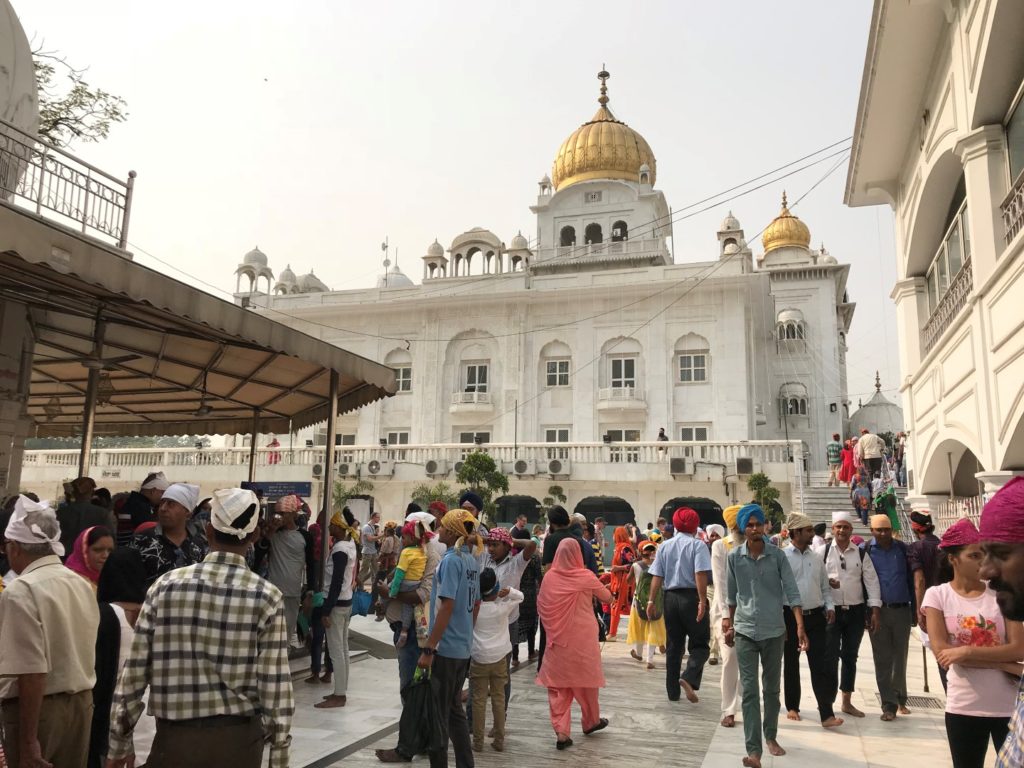
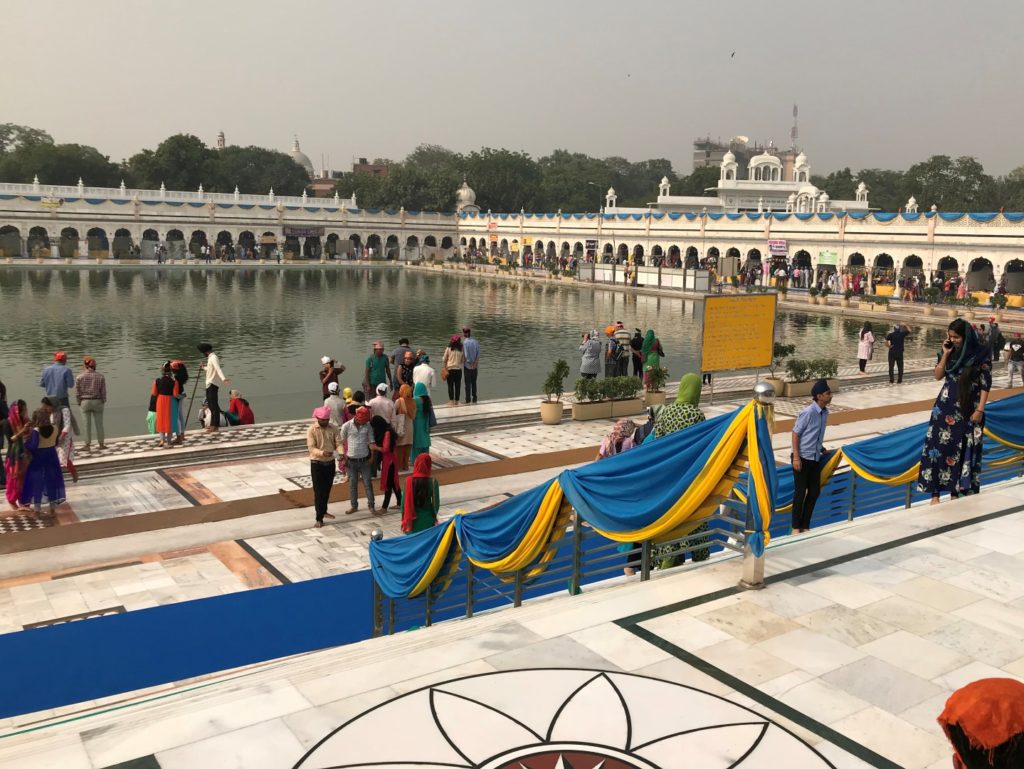
Our guide, Narottam, reminds us to take a breath before we head out again into the cacophony and chaos of the streets of Old Delhi. He’s right; it’s best to brace ourselves a bit for the onslaught. But we’re certainly ready for more.
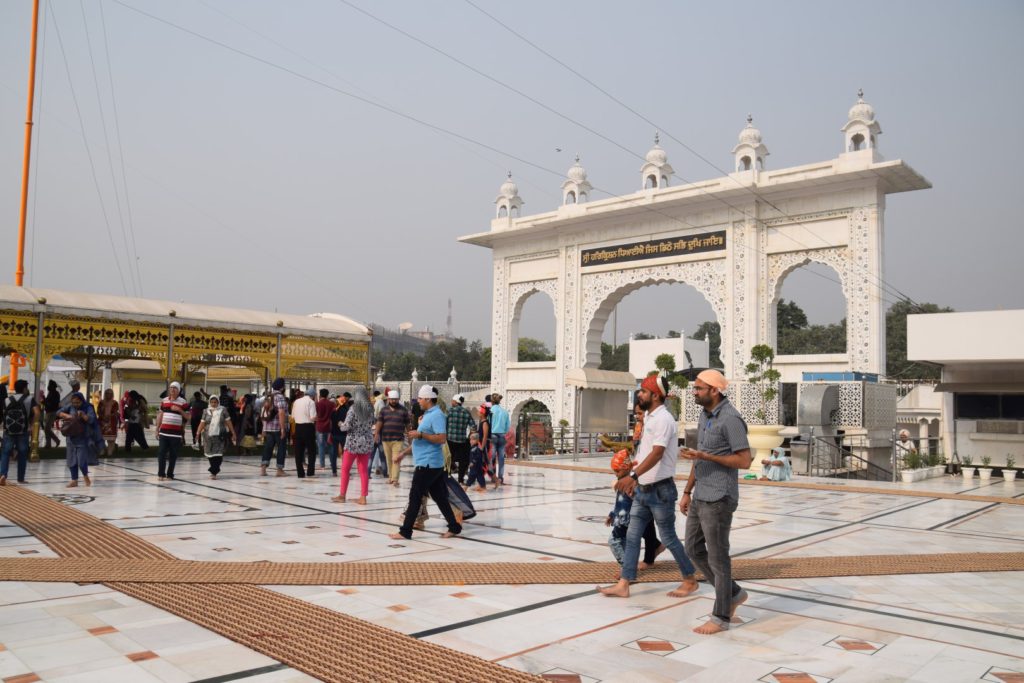
Wondrous India
My travels in India had many moments of beauty, wonder, laughter and unique experiences. In every instance, the Indian people are central to those moments, as is their history, art and culture. Our visit to the Sikh langar in New Delhi was one of those times where we saw the Indian people come together in community, generosity, and sacred grace.
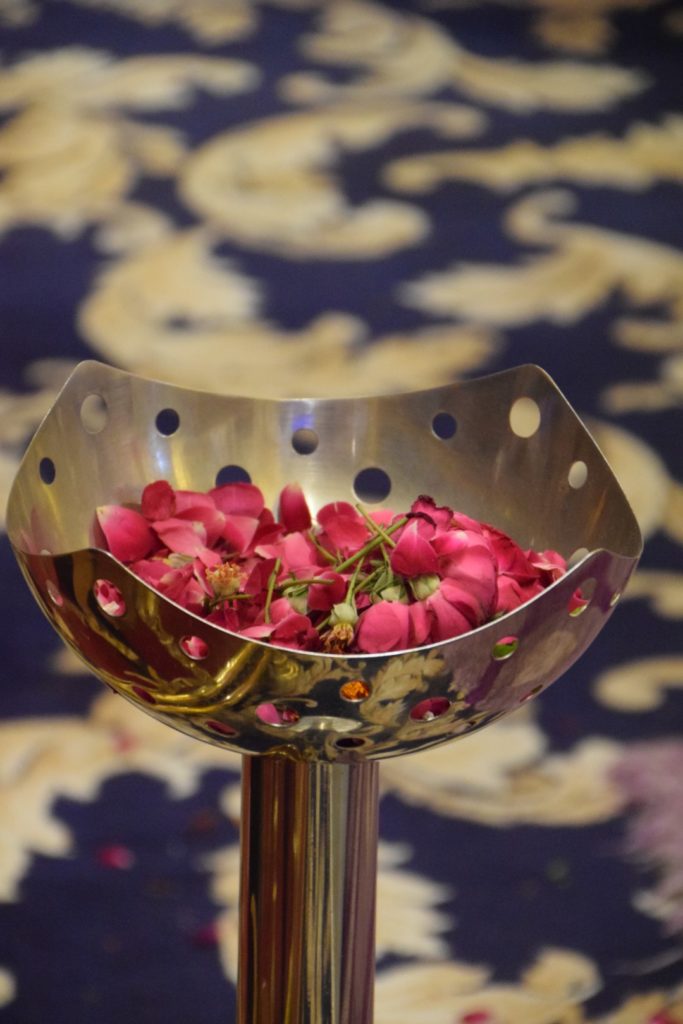
For More:
- The temple, Bangla Sahib Gurdwara , New Delhi The langar is managed by the Delhi Sikh Gurdwara Management Committee
- Delhi Tourism, https://www.delhitourism.gov.in/delhitourism/index.jsp
- Incredible India, Tourism Bureau, https://www.incredibleindia.org/content/incredibleindia/en.html
- On our site: We love India! See more articles about India: https://www.confettitravelcafe.com/?s=India/
-All photos by Nancy Zaffaro.

